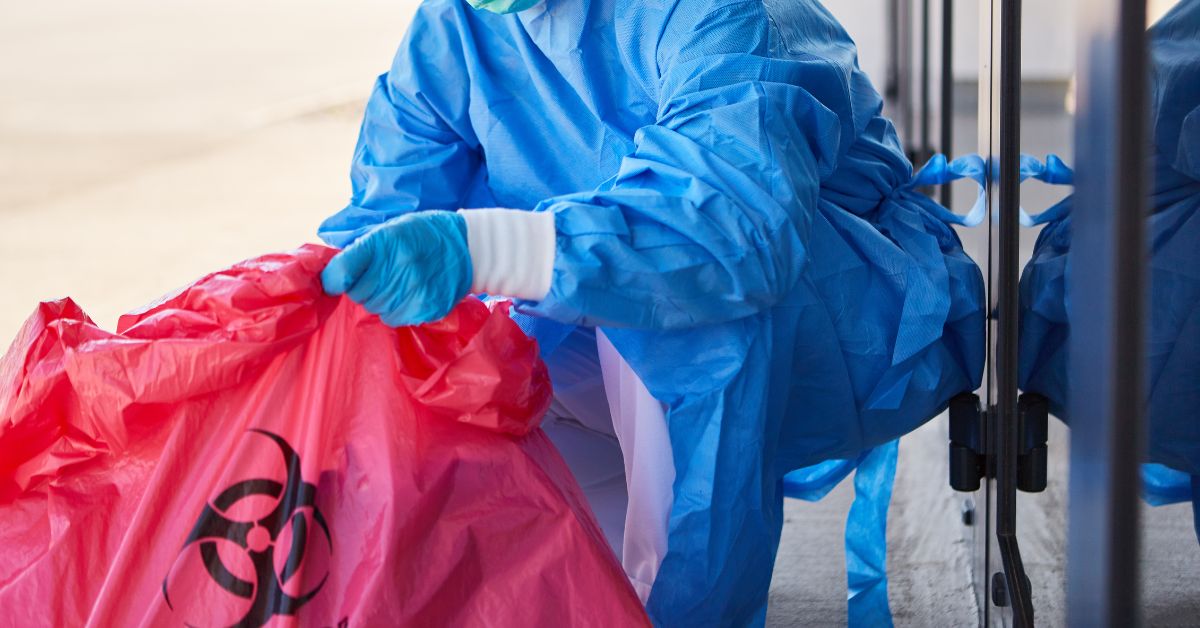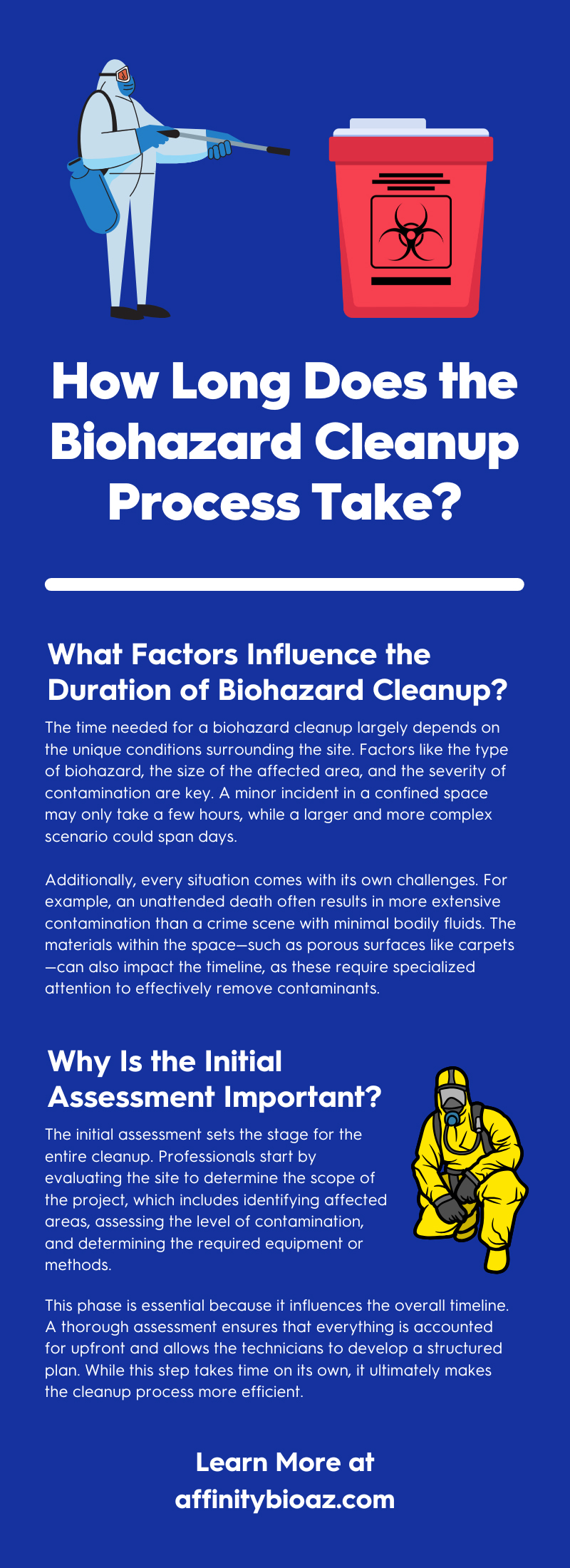
Cleaning up a biohazard scene is not just about rolling up your sleeves and scrubbing; it’s a meticulous process that requires training, precision, and careful planning. Furthermore, the duration of the cleanup can vary based on several factors. If you’re wondering how long the biohazard cleanup process takes, explore the variables involved in ensuring the safe and thorough cleaning of affected areas.
What Factors Influence the Duration of Biohazard Cleanup?
The time needed for a biohazard cleanup largely depends on the unique conditions surrounding the site. Factors like the type of biohazard, the size of the affected area, and the severity of contamination are key. A minor incident in a confined space may only take a few hours, while a larger and more complex scenario could span days.
Additionally, every situation comes with its own challenges. For example, an unattended death often results in more extensive contamination than a crime scene with minimal bodily fluids. The materials within the space—such as porous surfaces like carpets—can also impact the timeline, as these require specialized attention to effectively remove contaminants.
Why Is the Initial Assessment Important?
The initial assessment sets the stage for the entire cleanup. Professionals start by evaluating the site to determine the scope of the project, which includes identifying affected areas, assessing the level of contamination, and determining the required equipment or methods.
This phase is essential because it influences the overall timeline. A thorough assessment ensures that everything is accounted for upfront and allows the technicians to develop a structured plan. While this step takes time on its own, it ultimately makes the cleanup process more efficient.
Does the Nature of the Biohazard Matter?
The nature of the biohazard plays a huge role in determining how long the cleanup process will take. Biohazards aren’t limited to bodily fluids or crime scene aftermath; they can include chemical spills, infectious disease outbreaks, or even hoarding situations.
Each type of biohazard requires specific cleaning protocols. Professionals can resolve blood spills fairly quickly, while a hazardous chemical spill demands intricate steps for containment, neutralization, and disposal. Because the nature of the contamination varies, so does the time investment needed to clean the area effectively and safely.
Why Does the State of Contamination Affect Cleanup Time?
The severity of contamination directly impacts how long cleanup can take. A surface-level spill that hasn’t spread to surrounding areas is relatively quick to address. But once contamination penetrates deeper into carpets, furniture, or walls, the process becomes far more involved.
For instance, a biohazard cleaning company may need to remove contaminated drywall, furniture, or flooring to properly decontaminate a space. These extra steps, which go beyond surface cleaning, naturally add more time to the process. Each layer presents another phase of work needed to fully remove all traces of harmful substances.
How Does the Size of the Affected Area Impact the Timeline?
As mentioned, the larger the contaminated area, the longer it will take to clean. Cleaning a single room is vastly different from tackling an entire building. Larger spaces involve more surface areas to disinfect, making the process more time intensive.
With bigger areas, cleanup technicians also need to plan every step of the process to cover all affected zones thoroughly. This means more time spent assessing and addressing even the smallest details to make sure every area meets safety standards.
What Role Do Cleaning Methods Play?
The methods used during the cleanup process also affect the duration of biohazard remediation. Depending on the situation, technicians may rely on chemical treatments, mechanical tools, or specialized equipment like ozone generators.
Some cleaning methods are faster than others, but they depend on the nature of the contamination. For example, disinfecting a blood spill with a spray solution may take relatively little time. However, eradicating airborne pathogens or odors using an ozone generator might add hours to the cleanup process, as it takes time for these machines to effectively sanitize the air.
How Do Safety Protocols Influence Timing?
Safety protocols are constantly enforced during biohazard cleanup, and rightly so. These meticulous standards add time to the process but are non-negotiable for the health and safety of everyone involved. Technicians wear personal protective equipment (PPE), set up containment barriers, and follow strict guidelines to safely handle and dispose of hazardous materials.
Additionally, every tool and piece of equipment used during the cleanup must undergo proper sterilization afterward. These protocols are necessary to maintain safety and prevent secondary contamination, which is critical when dealing with biohazardous substances.
Can Weather or Environmental Conditions Cause Delays?
The surrounding environment can affect how long the cleanup process takes. For example, extreme heat may cause biological threats to deteriorate faster, which makes cleanup more complex. Cold conditions, on the other hand, may slow down the drying process for cleaned surfaces or materials.
Humidity levels and airflow also play a role when sanitizing and deodorizing large spaces. Technicians might need to dedicate additional time to make sure that all cleaned areas are thoroughly dry and free from lingering moisture that could harbor contaminants.
How Long Before the Space Is Safe To Reoccupy?
Reentry times depend on the specific biohazard scenario. Once cleanup is complete, professionals conduct tests to verify that each site meets established safety standards.
Some situations, like simple spills, may allow for reentry almost immediately after cleaning. However, scenarios involving airborne contamination or structural damage may require additional clearances that extend reentry times.
Is Communication With Professionals Necessary?
Clear communication with cleanup professionals can make a big difference in the overall cleaning experience. They’ll provide a clear timeline based on their assessment and keep you updated throughout the cleanup process.
If new challenges arise, prompt communication ensures they will address adjustments promptly and effectively. Knowing what to expect from the experts also helps you feel confident throughout the process.
When Efficient Cleanup Matters
Biohazard cleanup timelines can vary greatly, but understanding the factors involved helps set realistic expectations. Every phase, from assessment to reentry, plays a critical role in protecting everyone involved while restoring a safe environment. The combination of expertise, advanced cleaning methods, and safety protocols ensures the cleanup process is thorough.
If you’re looking for professional cleanup help, Affinity Bio Solutions has a team of certified technicians ready to handle your biohazard cleanup with care and efficiency. Contact us today for expert assistance you can rely on.

